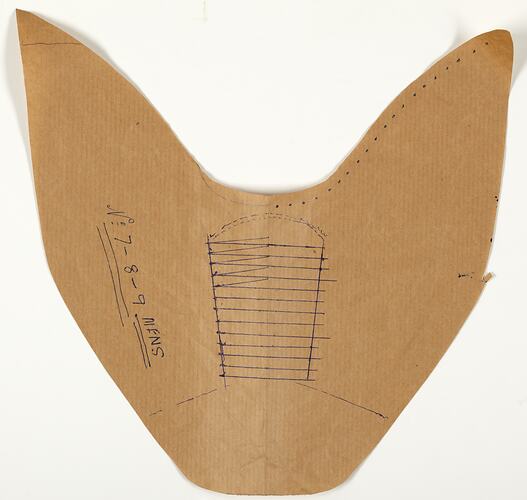Summary
Generated from everyday lined brown paper, this stylised U shape pattern was mostly used in creating the shoe's vamp area and was mostly likely used by Stanio Fancoff within creating his various shoe styles sometime between the 1930s and the 1970s. The indicators of dotted lines implies possible stitching, whilst its central horizontally lined vertical shape suggests the initial lacing systems and the text "No 7-8-9 MENS" references that this pattern was used for multiple sized mens' shoes. Along with many others, this pattern was an integral part to Stanio shoemaking craft and business.
Stanio Ivanoff Fancoff was born in 1908 in Bojentsi, a small village in Bulgaria. At age 11, Stanio left home to learn the shoemaking trade. In 1929, he immigrated to Melbourne, settled in Fitzroy and began to work for the V.G. Zemancheff & Sons basket shoe factory in South Melbourne. In1936, he married Dorotea Georgi Touzou who had recently arrived in Australia. Around this time, Stanio set up his own shoemaking business from home, with Georgi, her cousin and sister weaving the shoes which he then assembled. Select shoe samples were then taken to Sydney and Tasmania for sale. In 1942, Georgi and Stanio moved to Broken Hill for Georgi's health; there daughter Nancy was born and Stanio set up a shoe shop/factory. In 1945, Georgi died and by 1950 Stanio and Nancy had moved to Adelaide where he again opened a shoemaking business and shop. He passed away in 1978, having been in the shoemaking business for 59 years. This collection documents his migration and working life experiences.
Physical Description
Generated on lined brown paper, this stylised 'U' shaped shoe pattern has several pen markings. On the inner right edge, inset approximately 10mm, 20 penned dots spaced at an approximately 10mm apart mirror the edgeline, whilst the left side exhibits two small pencil mark lines. Centraly located within this pattern, an expanding vertical rectangular shape with 11 horizontal lines and a dashed semi-circle atop are drawn in pen. Below this shape, two diagonal lines manoeuvre from the rectangular shape to the outer edges of the lower pattern shape. Furthermore, on the left, underlined and written on the side is the text "7-8-9 MENS". The object appears in good condition but exhibits a small tear at the right hand outer edge's midway point and a curling of the upper corner edges.
Significance
This collection is significant in documenting a small migrant business as well as the fashion of a particular period. It is well provenanced and charts the application of trade skills in a new country. It also illustrates the stages of hand shoe manufacture from the 1930s, demonstrating the enduring nature of the tools and patterns that were used.
More Information
-
Collecting Areas
-
Acquisition Information
Donation from Nancy Vasileff, 21 Mar 2007
-
Maker
-
Inscriptions
Text: No. 7-8-9 MENS.
-
Classification
-
Category
-
Discipline
-
Type of item
-
Overall Dimensions
113 mm (Width), 265 mm (Height)
-
References
R.A. Salaman, 'Dictionary of Leather-working Tools c.1700-1950 and Tools of Allied Trades,' London: George Allen and Unwin (Publishers) Ltd, 1986 [Section 2: Boot and Shoe Maker pp18-185]. John Peacock. 'Shoes, The Complete Sourcebook,' London:Thames & Hudson Ltd, 2005. NAA holds file (online) on Vasil George Zemancheff, Fancoff's employer
-
Keywords
Boot & Shoemaking, Bulgarian Communities, Bulgarian Immigration, Immigration, Small Businesses

